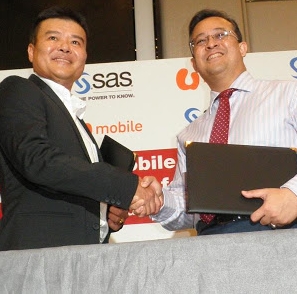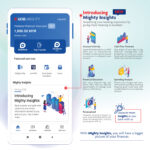By Charles F Moreira
Cellular network operator U Mobile is Malaysia’s first telecommunications service provider (telco) to use SAS Institute’s Visual Analytics tool, SAS Institute Malaysia and U Mobile announced in Kuala Lumpur.
| SAS Malaysia’s Andrew Tan (left) exchanges agreement with U Mobile CEO Jaffa Sany Ariffin |
“Visual Analytics is our new customer profiler system which gives us a competitive advantage, and we will use it to provide better services and offerings to our customers, and also to take into account new access devices such as tablets and smartphones which will be launched in the future,” said Jaffa Sany Ariffin, U Mobile chief executive officer.
 |
| SAS Visual Analytics |
“Prior to this, we used vendor-provided analysis tools from Ericsson and ZTE but we need a more highly sophisticated profiler system, so we chose SAS Visual Analytics. It lets our executives generate reports within minutes, instead of having to wait for information services to provide them the following day,” Sany added.
“The highly graphical Visual Analytics, lets U Mobile’s business executives easily analyse correlation, regression, exploration, make forecasts, customer usage patterns and other kinds of analyses on the huge volumes of data generated by its customers and is highly scalable to accommodate its future growth, without requiring them to have much technical knowledge to operate it,” said Andrew Tan, managing director of SAS Institute Malaysia.
It provides users with a Web-based interface, into which they can drag and drop data, to produce various types of graphs and charts. It also includes and lets multiple users collaborate on analysis projects and share information to make better informed decisions on what to do next to take next.
Visual Analytics is also accessible on tablets and smartphones, with downloadable applets for Apple iOS and Android devices.
It works with SAS’ high-performance in-memory LASR Analytic Server for fast analytics computation.
SAS announced Visual Analytics for workgroups and mid-sized business in February, and besides U Mobile, it’s already been implemented by a bank in Malaysia and is in process of implementation by a conglomerate here, Tan said.
Growing in a saturated market
Meanwhile, U Mobile currently has under 5 million subscribers or roughly 10% penetration, since it launched its 3G cellular service in March 2008, thus becoming Malaysia’s fourth cellular operator, well over 10 years later than its three established competitors in an already saturated cellular market.
“With 130% cellular penetration in Malaysia right now, we don’t expect any spectacular growth, and at best we expect to increase our penetration rate to 15% or 20% in the next five years,” said Jaffa. “We also are a very lean and low-CAPEX (capital expenditure) company, so don’t expect any announcements about big spending from us this year.”
Its big three competitors have also had the advantage of being able to rely on their legacy 2G network for revenue while they deployed and expanded their 3G network but with only a 3G license and spectrum, U Mobile’s 3G network has had relatively limited nationwide coverage, so its high-speed broadband Internet services was available mostly in densely populated areas of the Klang Valley, Negeri Sembilan, Perak, Penang and Johor; while U Mobile had to provide nationwide voice and SMS access through local roaming agreements over its competitors’ 2G networks.
However, its breakthrough came with its radio-access network (RAN) sharing agreement with Maxis in October 2011, the first such agreement in Malaysia; followed by the launch of 3G service over the shared infrastructure in November 2012.
Unlike a domestic roaming agreement where U Mobile rides upon another operator’s radio frequencies, with RAN sharing, U Mobile inserts its access card into Maxis’ base station antenna control equipment and provides the last-mile wireless connection to its subscribers over its own assigned spectrum in the 2.1GHz band.
However, this RAN sharing agreement does not cover spectrum in the 1.8GHz and 900MHz bands.
“This agreement lets us deploy our 3G services more widely without having to build more of our own base stations and infrastructure,” said Jaffa.
It was reported last November, that U Mobile’s major investor Tan Sri Vincent Tan said that this agreement with Maxis would save U Mobile RM2 billion in investments over the next 10 years.
Sorry, can’t tell you!
Sure, it’s tough being a relative newcomer in an already over-saturated market dominated by three well-established “big guys,” so now armed with Visual Analytics, how will U Mobile differentiate itself in services and what new services and offerings does it plan to launch?
“Sorry! That’s a trade secret so we can’t tell you right now, so wait until we announce them to our customers,” said Jaffa.
However, he said that U Mobile, which already has spectrum for LTE (Long Term Evolution), will launch LTE service sometime after the general elections and before the end of the year.
Why after the general elections? “We will have to promote our LTE service and we don’t want our message to be over-shaddowed by the pre-election fever.
At time of writing, the hot talk in cyberspace was that the Prime Minister, Dato’ Seri Najib Tun Razak will dissolve parliament on 3 April, paving the way for the next general elections, though others believe that mid-April is more likely.








